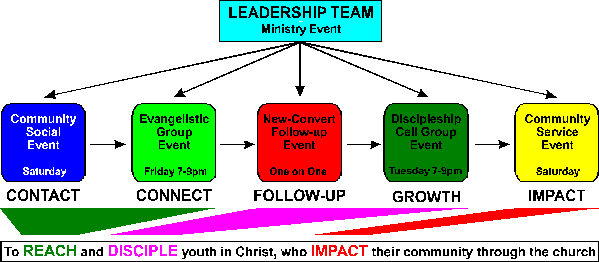
The creation of youth group mission statement is vital to the implementation of the Commitment Level Model of Youth Ministry. A separate missions statement should be created for each age group ministry within the local church.
1. The Value of Mission Statements
The mission statement is designed to reflect the purpose of ministry in and through the local church and also reflect the process of ministry that is implemented. It helps the youth ministry to be purpose-driven. When the group has identified their reason for existence, or their sense of purpose, they are then able to ensure that everything that is done works towards the fulfilment of their mission or purpose.
2. The Scope of Mission Statements
The purpose of ministry is captured in Matthew 28:18-20 where Jesus stresses the importance of making disciples. He hints at a strategy within the verses including: (1) making contact with people and building a relationship with them (“go and make disciples of all nations”); (2) evangelising them (“baptising them in the name of the Father, and of the Son and of the Holy Spirit); and (3) teaching them (“and teaching them to obey everything I have commanded you”). The mission statement should reflect the process of ministry by describing the key movements in ministry or the key dimensions of the ministry. The Windsor Fellowship’s teenage ministry shows how this works. The following diagram shows how the mission statement is linked to the various ministries - although it does not cover all the ministries, ie. the Ministry Event.

We exist to reach primary school children, and through them their families, with the Gospel of Jesus Christ, training them in the Word of God through Teaching, Missions, and Worship. Windsor Fellowship Children’s Ministry
We exist to reach and disciple youth in Christ, who through the local church will have an impact on their community. Windsor Fellowship Teenage Ministry
We exist to provide a point of meeting where we can meet the needs of young adults in our area, ie. to have fun; to have fellowship with others the same age and with similar beliefs; to receive Christian teaching; to be involved in outreach to the unreached and to pray together with other Christians. Windsor Fellowship Young Adult Ministry
We exist to turn irreligious high school students into fully devoted followers of Christ. Willow Creek's Student Impact
We exist to win, build and equip young people in Christ. Malibu, Hawaii
We exist to REACH non-believing high school age students with the gospel of Jesus Christ. To TEACH young believers how to grow and mature in their faith by assisting them in discovering their spiritual gifts. Ultimately, to SEND them into all the world that they might fulfill their purpose in life through ministry. Source Unknown
We exist to reach teenagers for Christ; nurture new Christians to spiritual maturity; and develop teens that can win their peers to Christ. Source Unknown
We exist to help young people start, develop and grow into a personal relationship with Jesus Christ. Kempton Park Presbyterian
4. The Writing of Mission Statements
The following process is suggested for developing a mission statement: The leaders should brainstorm to identify the process involved in reaching and discipling youth - to fulfil the Great Commission as in Matthew 28:18-20). This exercise should help to capture the key elements of ministry among youth, ie. outreach to unchurched youth; grounding new converts in the faith; growing Christian youth; training leaders; etc. Then in order to write the mission statement out the following question should be answered: Why do we exist? ie. “We exist to...”
5. The Communication of Mission Statements
Once the mission statement has been created it must be communicated to the whole ministry leadership team as well as the local church. It should be revised regularly and people should be encouraged to memorise it.
6. The Creation of Dream Statements
Mark Bushor wrote to the Youth Specialties forum about the creation of a dream statement to supplement the mission statement: "Besides having a purpose statement, we're also working on a Dream Statement. Due to our teenagers' growing passion to minister to the hungry, poor, homeless, etc., we're looking at possible Dream statements. We'll eventually use the Dream Statement to guide our SERVICE (or compassion) ministries. Our mission statement follows: "St. Mark Youth Ministries exists to provide junior and senior high students with meaningful opportunities for SPIRITUAL development, SOCIAL interaction, and SERVICE to all of humankind." The proposed Dream Statement follows: "We have a dream of a Church that feeds the hungry, that clothes the naked, that gives a cup of water to the thirsty, that visits the sick and the prisoner, that cares for the orphan and widow. We have a dream of a Church that cares for the baby in the womb, the child in the Third World ghetto, the elderly in the convalescent center, and the hurting person inside each of our hearts. We have a dream of the Church that advocates on behalf of the opressed, that dispells tenderness to the downtrodden, that confronts all forms of discrimination, and that challenges cruel dictators and landlords. We have this notion of a Community of Believers where the idea of compassion, love, forgiveness, honor and dignity are not mere doctrines---rather, they are a way of life."
Return to Model of Youth Ministry